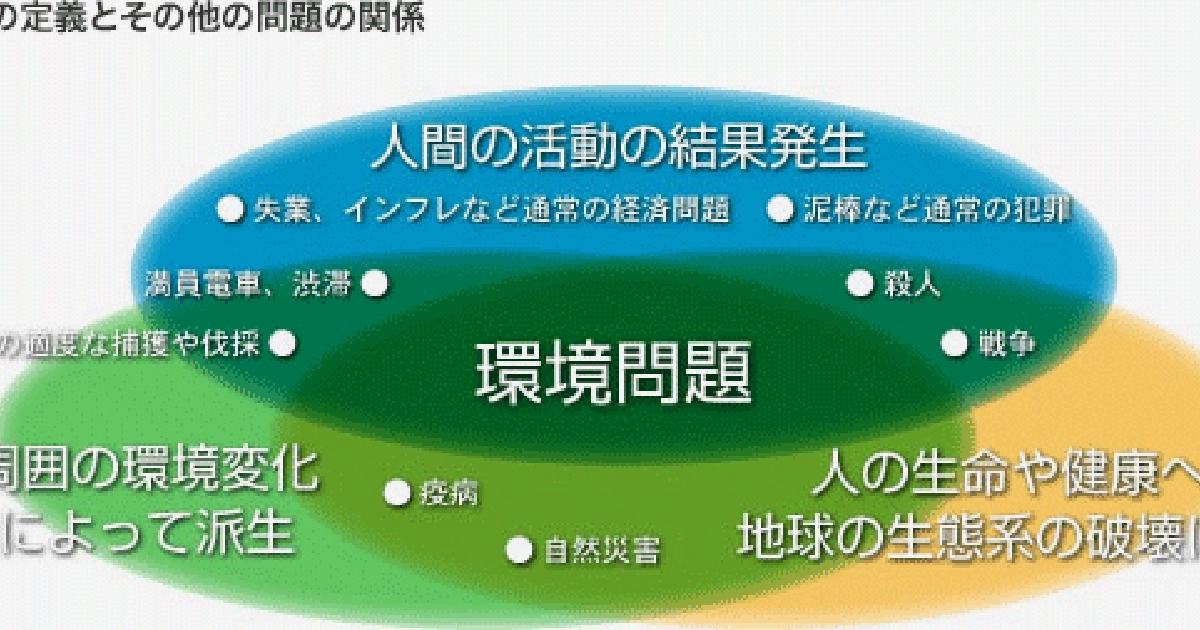Representative's Green Column
3. What are some of the environmental problems?
2008.07.15
Last column So, the environmental problem is "Caused by changes in the surrounding environment as a result of human activity In question, thereby directly or indirectly Damage to human life and health, destruction of the earth's ecosystem occurs There is a great risk of doing it. "
Then, specifically, what kind of environmental problems are currently recognized on the earth?
The following is a comprehensive coverage as much as possible.
- Excessive animal killing, plant logging
- Air, water, soil, Other contamination with hazardous chemicals
- Utilization and disposal of radioactive materials
- Increased ultraviolet rays due to ozone layer depletion
- Rapid warming
- Floods due to warming, droughts, increased typhoons, rising sea levels
- Land subsidence
- acid rain
- Desertification, deforestation
- Salt damage
- Shortage of energy, water, food and Other resources
- Garbage problem
- Health disorders caused by electromagnetic waves
- Other pollution problems (noise, vibration, odor, radio interference, light pollution, sunlight obstruction, etc.)
All of these problems are partly the result of human activity and are at risk of damaging human life and health or destroying the Earth's ecosystems.
Global warming, which is currently a hot topic (referred to here as rapid warming), has been discussed until recently, but the 10th meeting of the Intergovernmental Panel on Climate Change (IPCC) 1st Working Group In (January 29-February 1, 2007), "There is no doubt about the warming of the climate system." "Most of the global average temperature rises observed since the mid-20th century are of anthropogenic origin. It is quite likely that this was brought about by the increase in greenhouse gases in the world. ”It was almost confirmed that global warming was the result of human activities. In other words, it is almost certain that it falls within the definition of environmental problems.
However, what percentage of the increase in CO2 due to human activities accounts for the rise in temperature?
If more and more warming is triggered, what kind of damage is likely to occur and at what scale?
I think it is necessary to carefully look at such things based on scientific grounds, rather than relying solely on media reports. If you are careless, you run the risk of believing in something that is scientifically apparently wrong, such as the melting of Arctic sea ice and rising sea levels.
Floods, droughts, typhoons and rising sea levels are partly caused by warming, and it can be said that some parts are also caused by human activities.
The problem of garbage is regarded as one of the environmental problems, including the generation of CO2 and Other harmful substances by incinerating garbage, and the outflow of harmful substances after landfilling.
Ground subsidence is an environmental change that occurs as a result of human activities, as many of them are caused by the pumping of groundwater by humans, but it seems that this is not harmful to human life or health. I don't think it will affect the Earth's ecosystem. From my definition, I think it's just barely possible to include it in environmental issues.
Salt damage, which may not be familiar to you, is the so-called salt damage, some of which is caused by humans watering the earth. By sprinkling water for agriculture etc., the salt that existed underground rises to the surface of the earth, and then the water evaporates, causing the salt to precipitate and the salinity near the surface to rise. .. This causes the problem that plants such as agricultural products will not grow on the land.
Light pollution is hard to hear, but it seems that human activities may brighten the night and adversely affect the activities and growth of animals and plants. However, it may not be the destruction of the ecosystem at this point, so I think it is a delicate matter whether or not it should be included in environmental issues.
As you can see, there are a wide range of environmental problems, but if you look at each environmental problem, you can see the regional range of damage caused by it, the size of the people involved in it, and when it is caused. How long will the damage and risk last? In other words, the overall magnitude of damage varies.
Under such circumstances, thinking about countermeasures by focusing on only one problem, or conversely, treating such a wide range of problems at once with the same importance, both of which distort the countermeasures. , It may not be possible to obtain effective results overall.
July 15, 2008 Hironobu Matsui



